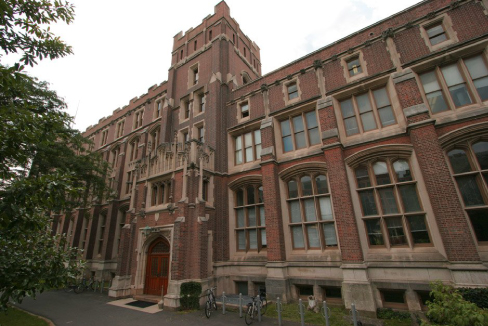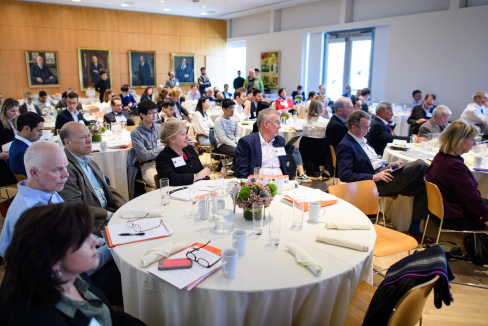Since the beginning of CMI grant, the Sarmiento and Pacala groups have performed a variety of studies to improve the understanding of carbon dioxide surface flux location, intensity and evolution in time and space. Their efforts have resulted in development of new sampling strategies, improvement of model components, and development of inversion methods. This work provides a unique knowledge base to allow the development of a carbon observing system that incorporates observation data from various origins along with different kinds of models (atmosphere, ocean and land) to monitor both short and long time scale changes in the carbon cycle and to provide predictions for the future.
Inversion modeling of land sinks
This year, the group of Professor Jorge Sarmiento continued its work with inversions to improve CO2 flux estimates for the tropics, where there are very few atmospheric observations to provide constraints for carbon fluxes. We have been able to gain considerable insights into the tropics by incorporating other types of observations. An ocean inversion that is analogous to the atmospheric inversions has been developed to estimate net air-sea fluxes of CO2 and other tracers using ocean interior tracer observations and ocean general circulation models. Unlike atmospheric inversions, the ocean inversion is not data-limited due to the relatively large number of high quality oceanic observations (over 68,000) and because the spatial footprints of air-sea tracer fluxes are preserved in the ocean interior as a result of the relatively long time scale of ocean circulation.
The ocean inversion was recently combined with an atmospheric inversion in a joint oceanatmosphere inversion. The joint inversion finds a remarkably large tropical and southern hemisphere land source of 1.8 ± 1.1 Pg C yr-1. Previous atmospheric CO2 inversions have not detected this source because the in situ atmospheric observations alone do not effectively constrain fluxes in the tropics and southern hemisphere. The join inversion removes this reliance on priors by strongly constraining air-sea fluxes, so that, as a consequence, the tropics become a net source.
In the past year, we finalized publications on time-independent air sea fluxes estimated from ocean interior data and models and their implications for terrestrial fluxes when combined with analogous atmospheric data and models. In addition, we employed forward simulations using the MOZART atmospheric transport model to examine whether the large tropical and southern hemisphere land fluxes estimated in Jacobson et al. (2007a, b) are consistent with atmospheric observations of the 13C/12C isotopic ratio in CO2 from the NOAA-ESRL flask network. Our preliminary results indicate that the results from the joint inversion generally match the observed latitudinal gradient, supporting the hypothesis of a large tropical and Southern Hemisphere land source. We are currently engaged in sensitivity studies to determine whether this result is robust.
Another major weakness of atmospheric inversions is the reliance on atmospheric transport models. Recent studies have shown that errors in these models can lead to biases in the estimates of the Northern Hemisphere terrestrial land sink on the order of 1 PgC yr-1 (Stephens et al., 2007). In collaboration with the NOAA Earth System Research Laboratory (ESRL), the Sarmiento group has developed a novel budgeting approach to circumvent the traditional weaknesses of atmospheric inversions. This approach exploits the new NOAA-ERSL network (20 sites) of aircraft profiles obtained as part of the North American Carbon program.
The direct carbon budgeting method finds a moderate carbon sink in the coterminous U.S. of – 0.51±0.39 GtC.yr-1 over the period 2003-2006. This sink is mainly distributed in the Midwest states, which are characterized by extensive agriculture, and in the Southeast regions where forests are regrowing. An additional sink is located in the south of the boreal region.
Land model development
A major achievement of Steve Pacala’s team has been the development of a new dynamic global land model, LM3, in collaboration with GFDL and USGS scientists. New simulations carried out by Elena Shevliakova and Sergey Malyshev suggest a terrestrial source due to land-use activities from 1.1 to 1.3 GtC/year in the 1990s, which is substantially smaller than the previous estimates. The analysis suggests a secondary vegetation sink of 0.35 – 0.6 GtC/year in the 90s and smaller cropland and pasture sources due to deceleration of agricultural land clearing since 1960s. The smaller magnitude of the land use flux in turn implies a smaller magnitude of the missing terrestrial sink, a finding that agrees with results from inversion modeling described above.
In another modeling advance, Sarmiento’s and Pacala’s groups have designed a data-based prognostic fire model for use in dynamic land models. This model estimates monthly burned area from four climate predictors (precipitation, temperature, soil water content and relative humidity) and one human-related predictor (road density). So far, due to the lack of reliable data over long time periods in other regions, this model has been designed for the boreal forest regions only. However, by exploiting observations of carbon dioxide from space, it is now possible, for the first time, to have a direct proxy for fire emissions in the tropics. Studies are underway to estimate the potential use of this new data to model fire in the tropics.
Pacala’s group is also working to understand how changes in climate will affect the geographic distribution of biomes and the mix of species that they contain. The feedbacks from the changes in the species composition are likely to have more significant feedbacks on climate and carbon cycling than the average changes in biomes’ properties. In order to represent changes in the species composition in the next generation of land models, the Pacala group has developed a new, analytically tractable demographic model of forest dynamics: the perfect plasticity approximation, PPA. The PPA model will enable scientists to understand the underlying causes of the local, regional, and global relationship between plants diversity and climate.
Finally, in order to understand the impact of global change on terrestrial carbon storage, Stefan Gerber, in collaboration with Michael Oppenheimer and Steve Pacala, is incorporating nitrogen cycling into LM3. A particular focus of the work is improving representation of biological nitrogen fixation (BNF), the most important nitrogen flux globally, compared with other current vegetation models. Experiments with the new model show the critical role of the nitrogen dynamics in terrestrial biomass accumulation. After disturbances, nitrogen limitation with reduced biomass growth can persist over millennia, but the rate of the recovery depends largely on strength of biological nitrogen fixation. Experiments have also been carried out to explore the role of the nitrogen in the so called CO2 fertilization effect. Preliminary results also point to BNF as one of the critical mechanisms if nitrogen is to limit plant growth in response to increased atmospheric CO2 (Figure 9).

Reconciling models and observations of ocean carbon fluxes
Dr. Keith Rodgers (in collaboration with Rik Wanninkhof at NOAA-AOML) has been using models and observations to identify and quantify the amplitude of the background variability in natural (pre-anthropogenic) oceanic dissolved inorganic carbon (DIC) in the upper ocean. Identifying and understanding the background variability may be an important step to reducing error in measurement-based estimates of the ocean uptake of anthropogenic CO2 through the CLIVAR/CO2 Repeat Hydrography Program.
Importantly, for both the Indian Ocean and the Southern Ocean, our simulations indicate that the seasonal-to-interannual changes in column inventories of DIC are closely related to changes in sea surface height from remote satellite measurements. This strongly supports the working hypothesis that much of the elevated natural variability is dynamically-driven, and points the way to the development of a new method that incorporates satellite altimetry measurements to separate the natural variability component of DIC from Repeat Hydrography measurements.
Michael Bender’s group continues to measure O2/N2 ratios in samples collected around the world, and use the results to calculate ocean and land carbon uptake worldwide. Their results show that, between 1994-2006, the oceans sequestered 2.1 Gt C/year and the land biosphere 0.7 Gt C/year. Also becoming evident in their data is evidence for an acceleration in the rate of ocean carbon uptake, estimated to be about estimated to be 1.0 +/- 0.5 Gt C/year between 1994-2005. This acceleration is the expected consequence of increasing rates of combustion and the increasing atmospheric burden of fossil fuel CO2.
Observational data are also being used to evaluate and improve model simulations of ocean CO2 uptake. An analysis by Sarmiento’s group has shown that estimates of contemporary oceanic uptake of anthropogenic carbon cluster quite tightly if models that do not fit radiocarbon and CFC observations are first eliminated, and that there is now a convergence of oceanic uptake estimates of anthropogenic carbon around a value of 2.2 ± 0.3 Pg C yr-1 for the early 1990s. This number is consistent with observation-based estimates made by Michael Bender’s group and represents a significant narrowing the estimated size of the ocean sink. The result also suggests that the terrestrial “missing sink” is much smaller than previously estimated.
Linking ocean circulation and biogeochemistry
Yves Plancherel, a graduate student in the Sarmiento group, in collaboration with Dr. Andrew Jacobson at NOAA/ERSL in Boulder, Colorado, is working on developing a statistical tool designed to gain insight into how ocean biogeochemistry is linked to the large-scale ocean circulation. Although further research is necessary to ground-truth preliminary findings, the results obtained thus far with CMI funds were sufficiently encouraging that the Sarmiento group was able to obtain three years of NSF funding awarded to continue this project.
Daniele Bianchi, another graduate student in the Sarmiento group, works on understanding the location and processes that control the upwelling branch of the meridional overturning circulation. This is a central problem in oceanography with implications from climate change to ocean productivity to deep-sea sequestration of anthropogenic carbon. Observational syntheses suggest that most of the upwelling occurs in the interior ocean, either spread broadly throughout the main thermocline or focused in regions of exceptionally intense mixing. However, a number of state-of-the-art numerical models suggest that the upwelling occurs primarily in the Southern Ocean. We included primordial Helium-3 emanating from mid-ocean ridges as a tracer in a suite of models with different representations of ocean mixing, representing the spectrum of behavior between upwelling occurring primarily in the Southern Ocean and upwelling occurring elsewhere. Preliminary results suggest that the models with upwelling in the Southern Ocean produce tracer distributions that are more consistent with observations.
Bianchi is also working with postdoc Eric Galbraith and Sarmiento to understand the physical and biological controls on open ocean anoxic zones, where water column denitrification takes place.



